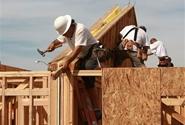Steel Markets

Apartment Construction Surges at End of 2016
Written by Sandy Williams
January 19, 2017
Housing starts rose 11.3 percent in December to a seasonally adjusted annual rate of 1,226,000 from a November revised rate of 1,102,000. Starts were up 5.7 percent year over year. Single family starts slipped 4 percent from the previous month but apartment type housing of 5 units or more rose 53.9 percent as new project construction commenced.
![]() Building permit authorizations, an indicator of future residential construction growth, was down 0.2 percent from November to a SAAR of 1,210,000. Year over year December permits grew 0.7 percent. Single family permits increased 4.7 percent to 817,000 units from November while permits for structures of 5 units or more showed some slowing with a decrease of 10.1 percent. On a year over year basis, single family permits were up 10.7 percent while 5-plus units fell 17.1 percent.
Building permit authorizations, an indicator of future residential construction growth, was down 0.2 percent from November to a SAAR of 1,210,000. Year over year December permits grew 0.7 percent. Single family permits increased 4.7 percent to 817,000 units from November while permits for structures of 5 units or more showed some slowing with a decrease of 10.1 percent. On a year over year basis, single family permits were up 10.7 percent while 5-plus units fell 17.1 percent.
Housing starts were strongest in the Midwest, increasing in total by 31.2 percent from November. Starts were up 23.5 percent in the West, followed by 18.5 percent in the Northeast. Starts declined by 1.4 percent in the South.
Permit authorizations were up 3.3 percent in the West, 2.7 percent in the Northeast, 0.5 percent in the Midwest, and declined 2.9 percent in the South.
For the entirety of 2016, an estimated 1,166,400 housing units were started; an increase of 4.9 percent from 2015. Building permits were up 0.4 percent from 2015 to 1,186,900 authorizations.
The National Association of Home Builders reported builder confidence remains solid in January.
“Builders begin the year optimistic that a new Congress and administration will help create a better business climate for small businesses, particularly as it relates to streamlining and reforming the regulatory process,” said NAHB Chairman Granger MacDonald.
“NAHB expects solid 10 percent growth in single-family construction in 2017, adding to the gains of 2016,” said NAHB Chief Economist Robert Dietz. “Concerns going into the year include rising mortgage interest rates as well as a lack of lots and access to labor.”

Sandy Williams
Read more from Sandy WilliamsLatest in Steel Markets

CRU: Sheet import demand softens as domestic price gains have slowed
US domestic sheet price gains have begun to slow as previously pulled-forward demand has led to a decline in orders.

CMC looks beyond Arizona micro-mill woes to long-term viability of construction mart
Despite the economic and geopolitical upheaval of the last five years, CMC President and CEO Peter Matt points out that the construction market has been an essential element of the way forward.

US importers face stricter rules under revamped S232 tariffs
“CBP expects full compliance from the trade community for accurate reporting and payment of the additional duties. CBP will take enforcement action on non-compliance," the agency said in a March 7 bulletin.

Steel exports rebound in January
US steel exports recovered to a five-month high in January after having fallen to a two-year low in December. This growth follows four consecutive months of declining exports.

Construction spending drops marginally in January
Construction spending edged down slightly in January, slipping for the first time in four months. The US Census Bureau estimated spending at a seasonally adjusted annual rate of $2,196 billion in January, down 0.2% from December’s downward revised rate. The January figure is 3.3% higher than a year ago. January’s result, despite the slight erosion, […]
